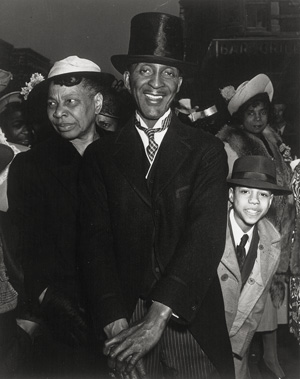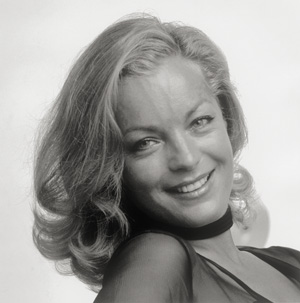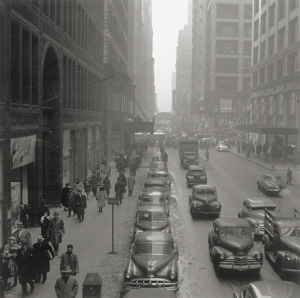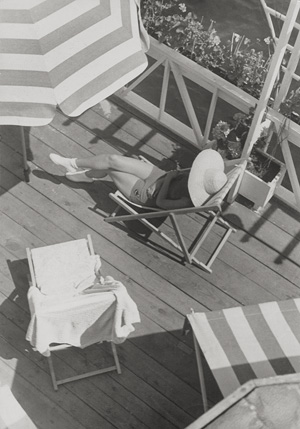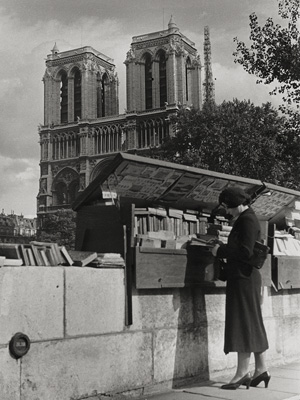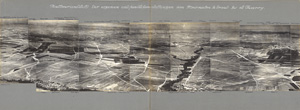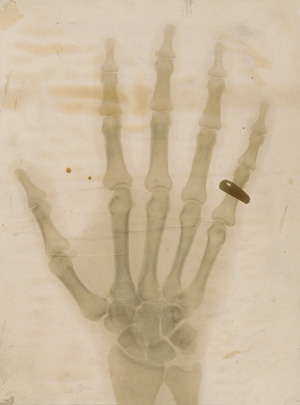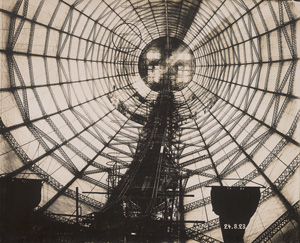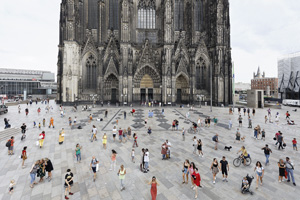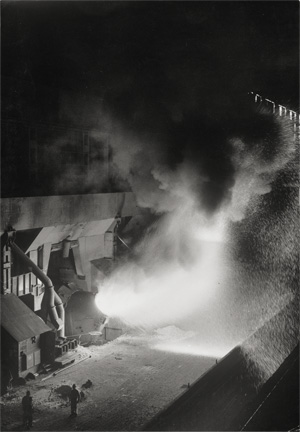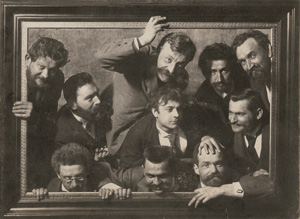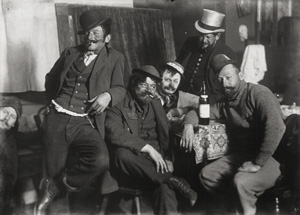Easter Sunday in Harlem. 1940. Gelatin silver print, printed circa 1980s. 25,1 x 20,2 cm. Annotated in pencil and ink on the verso.
Weegee, born Arthur Fellig, was a prolific photojournalist known for his stark, unflinching images of crime scenes, urban life, and street culture in 1930s and 1940s New York City. Often arriving at scenes before the police, thanks to his self-installed police radio, he captured raw, flash-lit photographs that combined documentary immediacy with a gritty, noir aesthetic. His work not only defined an era of tabloid photography but also offered a visceral portrait of the city’s underbelly, blending sensationalism with a distinct visual style. – Backed tear in upper edge, traces of previous mounting on verso, slight surface residue in lower right corner, a few light handling marks, otherwise in very good condition.
Lit.: Weegee (Arthur Fellig). Weegee’s New York: Reportagen eines legendären Photographen 1935-1960. Munich: Schirmer/Mosel, 2000, ill. p. 275.
Romy Schneider. 1972. Gelatin silver print, printed later. 41 x 40,5 cm (60,2 x 50 cm). Titled, dated and editioned "1/2" in ink in another hand as well as photographer's estate stamp on the verso.
The German photographer Reinhart Wolf is known for his fashion and portrait photography. He not only crafted iconic portraits of celebrities, models, and artists but also ventured into the realm of landscape and architectural photography, leaving an enduring mark on the world of photography with his versatile and influential body of work. – In excellent condition.
Provenance: From the estate of the photographer.
Chicago. 1950. Gelatin silver print, printed later. 50 x 49,5 cm (60 x 60 cm). Photographer's estate stamp on the verso.
Minimal buckling, otherwise in excellent condition.
Provenance: From the estate of the photographer.
Sun deck. 1930s. Vintage ferrotyped gelatin silver print on doubleweight paper. 24 x 16,7 cm. Photographer's "Frankfurt am Main" stamp, photographer's "Wiener Photo-Kurier" stamp annotated in pencil and red/blue crayon on the verso.
The German photographer Dr. Paul Wolff is renowned for his pioneering role in advancing modern photographic techniques, particularly in the use of the Leica camera. A master of lighting and composition, he helped define the aesthetics of 20th-century photography through both his portraits and dynamic reportage. His innovative vision and technical expertise left a lasting impact on the development of modern photography. – Corners bumped with some chipping to emulsion, a few nicks in edges, some light surface scuff marks, otherwise in very good condition.
Paris. 1930s. Vintage ferrotyped gelatin silver print on doubleweight Agfa-Brovira paper. 23,5 x 17,7 cm. Photographer's "Frankfurt am Main" stamp, annotated in pencil and "Schostal" agency label with photographer's name on the verso.
Corners slightly bumped, some light surface scratches, otherwise in very good condition.
Panoramic view taken from German military balloon between Mourmelon-le-Grand and St. Thierry, France. 1917. 26 gelatin silver prints mounted together on board and joined with paper tape to form a continuous panorama (entire size circa 19 x 141 cm). Handwritten notations in ink above and below images on the mounts, titled “Ballonrundblick der eigenen und feindlichen Stellungen von Mourmelon Le Grand bis St. Thierry”. Folded concertina-style.
This extraordinary panoramic photograph, assembled from 26 individual gelatin silver prints, documents the terrain between Mourmelon-le-Grand and St. Thierry in northeastern France during World War I. Taken from a German military observation balloon in 1917, the detailed images offer a sweeping view of both German and enemy positions, with handwritten notations identifying key strategic points along the horizon. Originally titled “Ballonrundblick der eigenen und feindlichen Stellungen von Mourmelon Le Grand bis St. Thierry,” the panorama reflects the importance of aerial reconnaissance in trench warfare and battlefield surveillance. Folded concertina-style, the work stands as a rare and visually compelling artifact of early military aerial photography. – Some oxidation mirroring, some fading in edges/joints, otherwise in good condition.
Photographer unknown. X-ray of a hand with a ring. Circa 1910. Vintage collodion print. 22,5 x 17 cm. Mounted to original board with gilt-ruled outline.
This striking early radiographic image captures the skeletal structure of a hand adorned with a ring, exemplifying the fascination with X-ray technology following its discovery by Wilhelm Röntgen in 1895. Likely made for scientific or medical demonstration, the print highlights the translucency of flesh and the opacity of metal in dramatic contrast. – Buckling from mounting, a few small spots and areas of discoloration, liquid staining in upper and lower corners, slightly faded.
Photographer unknown. Images of Zeppelin LZ 126 construction. 1922/23. 11 vintage ferrotyped gelatin silver prints. Various sizes between 21 x 25 cm and 17 x 23 cm. 3 with date in the negative in lower right corner, each with "Im Zeppelin über den Atlantic" film copyright stamp and annotated in ink/pencil on the verso.
This rare and historically significant group of photographs documents the construction of the airship LZ 126, later known as the USS Los Angeles. Produced as promotional material for the 1924 documentary film Im Zeppelin über den Atlantik, the images highlight key stages of the construction. The group also includes two rare interior views of the passenger cabin, offering a glimpse into the luxury and technical innovation of early transatlantic air travel. – Some photographs with discoloration, some oxidation mirroring in edges, a few small handling dents, corners slightly bumped, otherwise most in very good condition.
Domplatte, Cologne, Germany from the series "Places of Interest". 2020. Fine Art print on Hahnemühle paper, printed 2024. 80 x 120 cm. Label with printed title, therein signed and numbered "1/20" by the photographer in ink on the verso.
Rainer Zerback's "Places of Interest" series embraces the reality of popular tourist destinations, turning the flow of visitors into the central focus. Surprisingly, the presence of people in these landscapes enhances their attractiveness. In some respects, they appear more picturesque and engaging than the illusion of pristine, untouched nature and sites. This effect is achieved through harmonious positioning of people in the frame, and in post-processing digital techniques are employed to organize and intensify the crowds, virtually condensing the reality of these locations. – In near excellent condition with bright colors.
Lit.: E. Freiburger, J.S. Klotz von Eckartsberg, eds. Rainer Zerback: Aussenland. Neulingen: J.S. Klotz, 2024, ill. p. 39.
Industrial images (including 1 solarized print). 1960s. 5 vintage ferrotyped gelatin silver prints, 4 on Agfa-Brovira paper. Each between 30 x 23 cm and 29,5 x 20,5 cm. 3 with photographer’s stamp and 2 annotated by the photographer in pencil on the verso.
Hartmut Zickmantel served as a photography lecturer at the Cologne Werkkunstschulen. The photographs in this group were likely taken in the 1960s as part of his commissioned work for DEMAG AG (formerly Jünkerather Gewerkschaft) in Jünkerath, located in the Eifel region. – Some corners bumped, a few small handling dents, surface scratches and irregularities to ferrotype surface, otherwise in good condition.
Photographer: Heinrich Zille and unknown. Heinrich Zille with entourage. 1897- circa 1912. 5 gelatin silver and 1 collodion paper print. Circa 15 x 20 cm. Mounted to both sides of board.
These photographs show Heinrich Zille in a series of convivial group portraits taken in various interior settings between the late 19th and early 20th centuries. Surrounded by friends - likely fellow artists, writers, and members of his bohemian circle - Zille appears in relaxed, informal poses that convey a spirit of camaraderie. The images offer a rare glimpse into the personal and social world that shaped his artistic sensibility, capturing the warmth and cultural exchange of his milieu. – Some surface scuff marks, some faded, otherwise in good to very good condition.
Selected images. 1898-1906. 12 gelatin silver prints, printed later from the original negatives. Each ca. 21 x 26 cm (24 x 30 cm). 2 with "Berlinische Galerie" copyright stamp, 2 with printed "Griffelkunst" text as well as annotated in pencil on the verso.
The set includes the following titles: Handstand machende Jungen an einem Sandhang, Reisigsammlerin, Reisigsammlerinnen, Atelierfest bei dem Maler Walter Meyer-Lüben, Korb tragende Frau in hügeliger Landschaft, Hans Zille aus dem Wasser kletternd, Dornauszieher-Pose, Charlottenburger Schloss, Toreinfahrt, Parochialstraße 21 und 22, and Selbstporträt Heinrich Zille. One image is present in duplicate. – Some bumped corners, a few with slight handling dents, otherwise in very good condition.
Lit.: Enno Kaufhold. Heinrich Zille: Photograph der Moderne. Munich: Schirmer/Mosel, 1995, ill. plates 30, 55, 56, 76, 89, 112, 121,125, 131 and 140.
[*]: Regelbesteuert gemäß Auktionsbedingungen. [^]: Ausgleich von Einfuhr-Umsatzsteuer.
* Alle Angaben inkl. 25% Regelaufgeld ohne MwSt. und ohne Gewähr – Irrtum vorbehalten.
Galerie Bassenge
Erdener Str. 5A
14193 Berlin
Öffnungszeiten:
Montag bis Donnerstag, 10–18 Uhr,
Freitag, 10–16 Uhr
Telefon: +49 30 8938029-0
Fax: +49 30 8918025
E-Mail: info (at) bassenge.com
Impressum
Datenschutzerklärung
© 2024 Galerie Gerda Bassenge
Galerie Bassenge
Erdener Str. 5A
14193 Berlin
Öffnungszeiten:
Montag bis Donnerstag, 10–18 Uhr,
Freitag, 10–16 Uhr
Telefon: +49 30 8938029-0
Fax: +49 30 8918025
E-Mail: info (at) bassenge.com
Impressum
Datenschutzerklärung
© 2022 Galerie Gerda Bassenge

